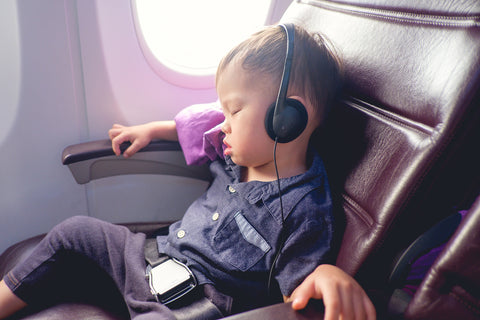Sure, travel is supposed to be fun — up until you’ve been dragged through several different time zones, completely wrecking your internal clock.
Jet lag disturbs your body’s internal clock, which can leave you feeling drowsy, irritable and just generally unwell. In some cases, jet lag can even cause stomach issues like diarrhea and constipation.
Fortunately, there are things you can do to minimize jet lag so you can hit the ground well-rested. Here are five ways to avoid jet lag, along with five tips for recovering if you end up feeling tired after a flight.

5 Tips for Avoiding Jet Lag
The best way to stop jet lag from dragging your circadian rhythm through the mud is to be proactive about how your body will react to long-distance travel.
You might not be able to eliminate all signs of jet lag, but you may be able to lessen its effects, so you can start enjoying your trip as soon as possible.
Maximize In-flight Comfort with a Weighted Blanket
If you’re a seasoned traveler, you probably already have go-to travel clothes that make flying as comfy as possible. Loose, cotton clothing lets you move about freely and keeps your body temperature regular. Many people also pack noise canceling headphones so they can sleep rather than listen to their seatmate snore.
However, there are other ways to ensure you stay as comfortable as possible on a flight. A weighted blanket may help you sleep better and stay that way rather than jolting awake with every bump of turbulence or pass of the beverage cart.
At SensaCalm, our Calm-to-Go weighted travel blanket is great for people who want to sleep on flights, as well as those who tend to feel nervous about flying. The compact design offers all of the benefits of our regular weighted blankets without any unnecessary bulk.
The Calm-to-Go rolls up easily and has attached carry handles for convenient transport. You can choose a four-pound, six-pound or eight-pound version depending on your needs.

Time It Right
Your trip, that is.
Jet lag usually occurs when you travel across more than two time zones, and it tends to be worse when you travel an eastward route.
If you’re someone who can sleep on an airplane, try to book an evening flight so you can get some sleep in the air. This works especially well if you have a long flight that allows you to fall into deep sleep for several hours.
Not everyone can sleep comfortably on a plane, however. If you find it difficult to rest in a cramped airline seat, try to time your flight in a way that lets you get a full night of sleep when you land. This might not alleviate all of your jet lag, but it will help ease the grogginess and exhaustion.
If you’re traveling across a few time zones, you can also start making small, gradual changes to your schedule in the weeks leading up to your trip. For example, if you normally go to bed at 10 p.m., start moving your bedtime up or down by a half hour every few days in the weeks prior to your departure. You can do the same with mealtimes.
Avoid Alcohol and Caffeine
It’s tempting to reach for caffeine when you’re tired. If you’re a nervous flyer, you might also have a drink or two prior to your flight. However, both caffeine and alcohol can make jet lag worse.
According to one study, “Both alcohol and caffeine can adversely affect quality of sleep when they are consumed a few hours before bedtime; caffeine intake should be planned to enhance daytime alertness. When passengers are traveling, they are advised to avoid alcohol, especially while they are being treated for jet lag.”
Stay Hydrated
The recycled air inside airplane cabins can quickly make you dehydrated. Whereas most people feel comfortable with between 30 and 65 percent humidity, the humidity inside an airplane is between 10 and 20 percent — about what you find in the desert. If you step off the plane dehydrated, it can make your jet lag worse.
You can help prevent dehydration by drinking enough water while you fly. The Aerospace Medical Association recommends drinking about eight ounces of water for every hour you’re in the air.
Set Your Watch to Your Destination’s Time Zone
When you travel long distances, travel experts like Rick Steves recommend switching your watch — and your mindset — to your destination’s time zone as soon as possible. This gets your mind thinking in local time, and it helps your body adjust to a new schedule.
After you land, avoid the temptation to constantly figure out what time it is back home. As Steves puts it, “Don't prolong jet lag by reminding yourself what time it is back home. Be in Europe.” (Or wherever you’re flying.)

5 Tips for Easing Jet Lag
If you’re traveling through multiple time zones, chances are you’re going to experience at least some jet lag. The groggy, tired feeling can put a dent on your trip and sometimes even stop you from seeing the sights or checking items off your itinerary.
Fortunately, it’s possible to manage jet lag. Here are five jet lag tips to keep in mind the next time you travel.
Sleep When the Locals Do
When you’re exhausted from jet lag, your first instinct might be to find the nearest bed and hop in it. However, it’s best to get your body in sync with the local schedule as quickly as you can. Resist the urge to sleep as soon as you check in at the hotel.
If you arrive in the middle of the afternoon, for example, try to force yourself to stay up until an appropriate bedtime. It might be tough at first, but it may help you beat the jet lag faster.
Get Some Natural Light
You may also be able to ease jet lag by simply stepping outside. The National Sleep Foundation recommends getting outside and taking in as much light as you can. “Try to get outside in the sunlight whenever possible. Daylight is a powerful stimulant for regulating the biological clock. (Staying indoors worsens jet lag.)”
Do Some Moderate Exercise
A workout may be the last thing you feel like doing when you’re jet lagged. However, even a brisk walk may help your body adjust to a new time zone. Paige Waehner at Verywell Fit recommends a short walk outside or a quick exercise routine in your hotel room. Limit yourself to 20 or 30 minutes of moderate activity. It may be hard at first, but the effort will pay off.
Pack Some Comforts from Home
One of the downsides of traveling is sleeping in an unfamiliar environment. If you find it hard to settle in when you’re in a new place, why not bring some of your home along with you on your trip?
You don’t have to bring an extra suitcase filled with knick-knacks, but you can probably squeeze a favorite photo, pillow or coffee mug into your carry on. Having a few familiar items around you might help you feel more relaxed when it’s time to sleep.
Use a Weighted Blanket
Travel can cause short-term insomnia, which can definitely throw a wrench in your plans. Weighted blankets use a type of therapy called deep pressure touch stimulation to provide firm but gentle squeezing and hugging of the body. Research has shown that this type of touch can ease anxiety.
Additional studies have shown that weighted blankets can help people who suffer with insomnia. For example, a study published in the Journal of Sleep Medicine & Disorders found that “a weighted blanket may aid in reducing insomnia through altered tactile inputs, thus may provide an innovative, non-pharmacological approach and complementary tool to improve sleep quality.”
To stop travel-related insomnia in its tracks, try using a weighted blanket on your next trip. You can also pack a weighted wrap, which drapes around the shoulders or over the thighs for extra sensory input and soothing.
Get Your Calm-to-Go Weighted Travel Blanket Today
Going on a trip soon? Travel more comfortably with the Calm-to-Go weighted travel blanket. Whether you’re looking to ease the symptoms of jet lag or you want to settle your nerves on a flight, the Calm-to-Go lets you travel with all the benefits of a traditional weighted blanket in a convenient, portable size.
You can also order a custom weighted blanket, or choose one of our finished weighted blankets, which ship the next business day after your order.
Questions? We’re here to help. Give us a call at 855-736-7222 or use our contact form to get in touch with one of our team members.
Disclaimer: The content on this website is not intended as a substitute for medical advice. Talk to your doctor or healthcare provider before undertaking any type of therapy or treatment.


